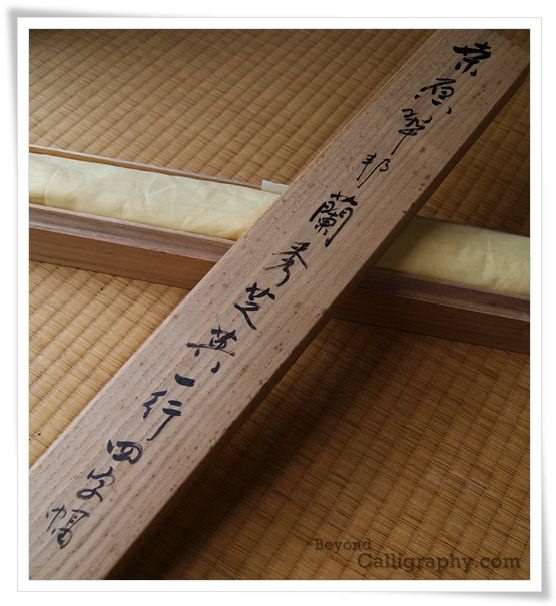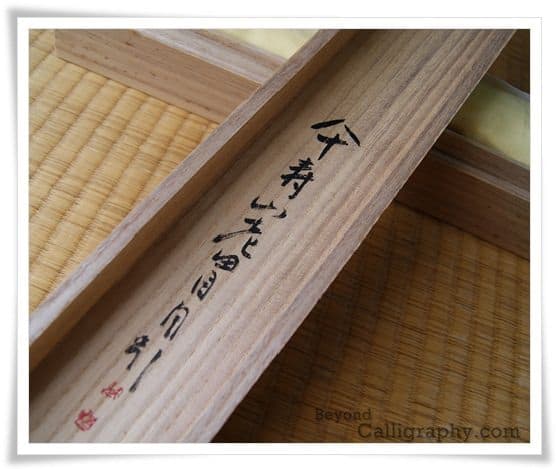In this article on hanging scrolls I would like to explain one of the correct ways of signing the protective box that comes with the scroll. Naturally, the method below does not encompass everything there is to be said about the practice of signing scroll boxes. Nonetheless, it should serve as a good example of how it is done traditionally.
After the calligraphy is mounted on a scroll, a custom sized box is crafted that protects the scroll from dust, insects and damage. Such a box is (traditionally) made of Paulownia wood (in Japanese it is known as 桐箱 (きりばこ, kiribako), which is further secured in a paper box, or another wooden box. Once the scroll is returned to the calligrapher, he places his signature and seal on the box. Without the calligrapher’s signature and seal, the scroll will not be as highly valued. As with everything in calligraphy, there is an interesting way to sign kiribako.

As shown in Figures 1 and 2, you can see the outside and inside lid inscriptions, written by Grand Master Kuwahara Suihō (桑原翠邦, くわはら すいほう, 1906 – 1995). The inscription in semi-cursive script (行書, ぎょうしょ, gyōsho) on the top of the lid reads: 桑原翠邦蘭秀芝英一行四字幅 (くわはら すいほう らんしゅうしえい いちぎょう よじ ふく, Kuwahara Suihō ranshūshiei ichigyō yoji fuku). The inscription explains that the scroll (幅) inside the box was written by Grand Master Kuwahara Suihō (桑原翠邦). The text on the scroll has one row of characters (一行) and it consists of four kanji (四字). The text itself reads: 蘭秀芝英. 蘭秀芝英 is a 四字熟語 (よじじゅくご, yoji jukugo, i.e. “four characters idiom”) used on the occasion of congratulating someone. The phrase translated means “a lawn of beautifully blooming orchids” which is a phrase used to highlight the success of someone’s endeavour, or simply offer our best wishes. This particular scroll was a gift from Grand Master Kuwahara Suihō to my calligraphy teacher (who was at that time Grand Master Kuwahara Suihō’s disciple) on the occasion of him starting his own calligraphy and classic literature research group in Tokyo, of which I am a proud member.

The inner lid inscription (Figure 2) is the signature of the calligrapher who wrote the calligraphy in the box. The text reads: 傘壽山老魚目自題 (さんじゅさん ろう ぎょもく じだい, sanjusan rō gyomoku jidai), and it is followed by two seals. 傘壽山 is a coded indication of his age. These kanji make little to no sense if read normally: 傘 (umbrella) 壽 (longevity) 山 (mountain). However, the symbolism of calligraphy is playing its part here and the reading needs further explanation. The kanji 傘 written in cursive script will consist of two elements that resemble characters 八 (はち, hachi, i.e. “eight”) and 十 (じゅう, jū, i.e. “ten”). The character 山 has the same sound as 三 (さん, san) which means “three”. It is possible that the 山 is a reference to the impressive knowledge that one possesses at the age of 83, or simply that if one reaches such an advanced age, he is ancient and calm as a mountain range. Lastly, 老 sands for “old age”.
So there you have it, Grand Master Kuwahara Suihō was 83 when he wrote the calligraphy hidden in this particular box.

The second part of the inscription (魚目自題) is a signature. Calligraphers usually have one main pen name; however, they may have other pen names. In case of Grand Master Kuwahara Suihō his main pen name was 翠邦 (Suihō), which literally means “green county (or home town)”. One of his other pen names was 魚目, i.e. “fish eye”. The last part of the inscription (自題) means that he himself chose the phrase for the scroll.
The two seals below the signature read 翠邦 (Suihō), and confirm the authorship of the work.
As I mentioned at the beginning of this article, the Paulownia box is inserted in a hard paper box. The Paulownia box should be inserted in a way that when removed from the paper box, the top part of the phrase 桑原翠邦蘭秀芝英一行四字幅 should show first. This way, one does not have to remove the entire box from the paper cover to see what scroll is inside. Calligraphers may have hundreds of scrolls in their collection, since displayed scrolls are meant to be replaced with others every ten to fifteen days. This prevents them from aging, and allows the insect repellent that is inserted in the box to imbue the scroll with its smell, protecting it from damage. Calligraphy mounted on scrolls often represents a seasonal phrase, and they need to be changed accordingly. Lastly, the change of scrolls reminds us of the impermanence of things, and the joy of anticipation of waiting for our favourite scroll to be hung on the wall once more.
In Figure 3 you can see the scroll hanging on the wall. The text 蘭秀芝英 is written in cursive script, and the inscription on the left indicates that this particular calligraphy was dedicated to Master Kajita Esshū (梶田越舟, かじた えっしゅう, 1938 – present), as I mentioned earlier on.
In Part III of this article series I will be explaining how to maintain a hanging scroll, and show you the proper way of rolling it and securing it in the box.
Hanging Scroll part I can be found here
